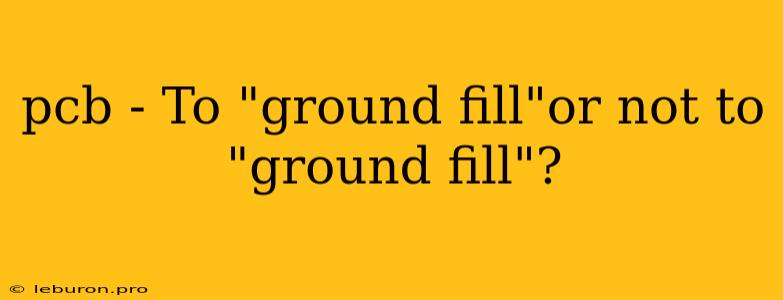In the realm of printed circuit board (PCB) design, there's a constant pursuit of optimal performance and reliability. One design technique that sparks debate is the use of ground fills. Ground fill, a technique where a contiguous area of copper is poured on the PCB, serves a multifaceted purpose. This article will delve into the advantages and disadvantages of employing ground fills, examining the crucial factors that determine when they are beneficial or detrimental.
The Purpose of Ground Fills
Ground fills play a pivotal role in achieving signal integrity and reducing electromagnetic interference (EMI). They provide several key benefits:
1. Reduced Noise and Improved Signal Integrity:
Ground fills act as a low-impedance path for ground currents, minimizing the impact of noise generated by switching signals. This results in cleaner signal transitions, enhanced data transmission, and improved circuit performance. By reducing the overall inductance of the ground plane, ground fills contribute to a more uniform ground potential across the PCB, mitigating noise and crosstalk between signals.
2. Shielding and Reduced EMI:
Ground fills serve as an effective shield against electromagnetic interference. The solid copper area acts as a barrier, preventing external electromagnetic fields from penetrating the PCB and disrupting the circuit's functionality. This is particularly crucial for sensitive electronics operating in harsh electromagnetic environments.
3. Improved Power Distribution:
In addition to signal integrity, ground fills play a crucial role in power distribution. By providing a large, low-resistance pathway for return currents, they ensure consistent power delivery to all components. This is essential for maintaining stable voltage levels and preventing voltage drops, which can impact device performance and reliability.
4. Enhanced Thermal Management:
Copper has excellent thermal conductivity, making ground fills contribute to improved heat dissipation. The large surface area of the filled ground plane provides a path for heat to be conducted away from heat-generating components, minimizing localized temperature increases and enhancing the overall thermal performance of the PCB.
The Downside of Ground Fills
While ground fills offer significant advantages, they also come with potential drawbacks that must be carefully considered during the design process.
1. Increased PCB Cost:
Adding ground fills to a design inevitably increases the amount of copper used, which translates to higher material costs. This can be a significant factor in budget-constrained projects, particularly for high-volume production runs.
2. Manufacturing Challenges:
The fabrication of PCBs with extensive ground fills can present manufacturing challenges. The larger copper areas can create more opportunities for solder defects or delamination, requiring tighter process control and potentially increasing the risk of production issues.
3. Potential for RF Interference:
While ground fills can effectively shield against EMI, they can also act as antennas at high frequencies. This can potentially introduce RF interference, particularly in high-speed digital designs where signals operate at frequencies exceeding a few hundred MHz.
When to Use Ground Fills?
The decision of whether or not to employ ground fills is ultimately a balancing act. Here's a guide to help you make an informed choice:
- High-Speed Digital Designs: In applications involving high-frequency digital signals, ground fills are often essential to ensure signal integrity and minimize noise.
- Sensitive Analog Circuits: Ground fills can be beneficial for sensitive analog circuits, especially those susceptible to electromagnetic interference.
- Power-Intensive Applications: For circuits with significant power consumption, ground fills can improve power distribution and thermal management, preventing voltage drops and excessive heat generation.
When to Avoid Ground Fills?
There are instances where ground fills can be detrimental:
- Very Low-Frequency Applications: For applications involving low-frequency signals, the benefits of ground fills may be minimal.
- High-Density Designs: In designs with a high component density, ground fills can make routing more challenging and potentially hinder signal integrity.
- Budget-Constrained Projects: The increased manufacturing costs associated with ground fills may not be feasible for projects with strict budget limitations.
Optimizing Ground Fill Usage
To maximize the benefits of ground fills while minimizing their downsides, consider the following:
- Selective Ground Fills: Instead of filling the entire PCB with copper, consider using ground fills strategically in areas where they are most needed, such as around high-speed signals or sensitive analog circuits.
- Partial Ground Fills: Employing partial ground fills in critical areas can strike a balance between performance and cost.
- Ground Fill Patterns: Choose a pattern for your ground fill that minimizes the risk of RF interference while providing adequate noise reduction.
Conclusion
Whether or not to employ ground fills is a design decision that requires careful consideration. By weighing the advantages and disadvantages, understanding their impact on different circuit types, and optimizing their implementation, engineers can leverage the benefits of ground fills to enhance PCB performance and reliability.
